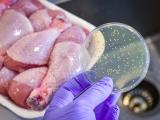Dec 3, 2001 (CIDRAP News) A new study commissioned by the US Department of Agriculture (USDA) indicates that the risk of bovine spongiform encephalopathy (BSE) occurring in the United States is extremely low, but USDA officials who released the study said they are considering taking steps to lower the risk further.
"What we found is that the United States is very resistant to BSE. As far as we know, it's not here now, but if it does get in, it can't become established," Dr. George Gray, director of the risk assessment, said at a USDA press conference Nov 30. Gray is deputy director of the Harvard Center for Risk Analysis, which conducted the study for USDA.
Agriculture Secretary Anne Veneman said the study shows that federal steps to keep BSE at bay are working, but added, "We must continue to improve and strengthen our firewalls, and we are committed to do just that." She announced that USDA will test 12,500 cattle samples for BSE this fiscal year, up from 5,000 in fiscal 2001, and will propose a ban on the use of certain devices used to stun cattle before slaughter. In addition, the department will consider several other steps:
- Banning the use of brain and spinal cord from certain cattle in human food
- Banning the use of central nervous system tissue in boneless beef products, incuding meat from advanced meat-recovery (AMR) systems
- Banning the use of the vertebral column in certain categories of cattle, including downed animals, in producing meat from AMR systems
- Imposing new regulations on the disposal of dead stock on farms and ranches
Officials said the steps being considered will be published in an upcoming "policy options paper" and, in the case of the rules on disposal of dead animals, in an "advance notice of proposed rulemaking."
USDA commissioned the Harvard study in 1998 in order to evaluate the effectiveness of US measures to prevent BSE. In 1989 the nation banned the importation of live ruminants (cattle, sheep, and goats) and ruminant meat and bone meal from the United Kingdom and other countries with BSE. The ban was extended to the rest of Europe in 1997. In addition, the Food and Drug Administration (FDA) in 1997 banned the use of most mammalian protein in animal feed intended for cows and other ruminants.
The authors of the Harvard study developed a mathematical model to predict how many cases of BSE could occur if various numbers of infected cattle were imported into the United States. For example, the report states, "In a hypothetical scenario in which ten cattle infected with BSE are imported into the U.S., on average only three new cases of BSE would occur. Moreover, the disease is virtually certain to be eliminated within 20 years after introduction" if current safeguards stay the same.
"We ran dozens of scenarios and thousands of variations of each of those with our model, and we couldn't come up with a single situation where BSE could take hold or spread in any significant way," said Gray. Even the importation of 500 infected animals would not trigger a major outbreak, he said. He cited the ban on use of mammalian protein in ruminant feed as the key barrier to spread of the disease.
The study authors also examined the possibility that British cattle imported between 1980 and 1989 could have brought BSE to American shores. USDA has determined that 334 cattle were imported in that period, and 161 are known to have been disposed of safely, but safe disposal has not been verified for the other 173 cattle. The study concluded that there is only an 18% probability that US cattle were exposed to BSE from those animals. "Even if U.S. animals were exposed to BSE, there is a significant chance that the exposure resulted in no new cases of disease," the report says. If the pre-1989 imports did introduce the disease, safeguards adopted in the last 5 years most likely "have arrested the disease and begun to eradicate it," the document states.
The Harvard team also concluded that if infected cattle were imported, only a small amount of tainted meat would reach the human food supply. "In the entire 20-year period following the import of ten BSE-infected cattle, the mean estimate for the amount of infectivity potentially available for humans is 35 cattle oral ID50s," the report says. One cattle oral ID50 is the amount of infectious tissue that would cause 50% of exposed cattle to contract BSE. How one cattle oral ID50 would affect humans is unknown, but European authorities suggest that the cattle disease may be much less virulent in people, the report says.
The report also says there appears to be "no potential" for an epidemic of BSE resulting from cross-species transmission of diseases related to BSE, such as scrapie in sheep and goats and chronic wasting disease in deer and elk.
The American Meat Institute (AMI) praised the report as a confirmation of earlier studies showing a low risk of BSE in the United States. In a news item on the institute's Web site (MeatAMI.com), an AMI official said the nation's freedom from BSE is a result of the "triple firewall strategy," consisting of import barriers, feed controls, and cattle testing.
The Center for Science in the Public Interest (CSPI), a nonprofit group in Washington, DC, that studies food safety and quality, took a somewhat different view. Though the CSPI did not specifically critique the study, Caroline Smith DeWaal, CSPI's food safety director, said current regulations are not adequate to protect the human food supply or to prevent the spread of BSE in cattle. In a statement on the CSPI Web site, she said USDA should ban the use of cattle spinal cords, spinal columns, and other infectious tissue in the human food supply and also ban the use of mammalian tissue in feed for pigs and poultry.
See also:
Transcript of USDA press conference on report
http://www.usda.gov/documents/NewsReleases/2001/11/0243.doc
USDA press release about the report and proposed additional steps to prevent BSE
http://www.usda.gov/documents/NewsReleases/2001/11/0241.doc
USDA's BSE Web page
http://www.aphis.usda.gov/newsroom/hot_issues/bse/index.shtml



















